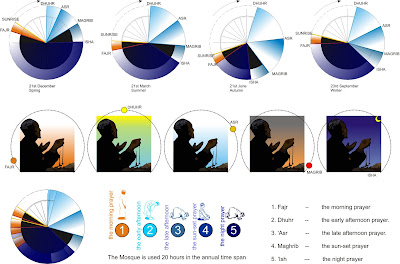










The scheme of the nowadays Mosque generated from the first Mosque in Medina

Common elements of First Mosque and nowadays Mosque




Imam's Are elements/furniture











Critical Regionalism
Islamic culture has a basic unity founded on the Koran, as the word of God. But quite a variety of forms of every order have been created during its history. There are oceans between the architectural concepts of Badshahi Mosque at Lahore, of the Selimiye at Edirne and of the Great Mosque at Cordoba. What is important in their shaping is not the common ground of Islamic culture, but the local interpretation of it. What makes them truly symbolical is their relationship to the soil, to the physical environment on which they were built, the cultural and political environment in which they were created.

the simplicity of the mosque form, generally a square overall plan with covered colonnades along the qibla wall, has remained the primary mosque-type to the presenftime. The function of the mosque is to let Muslims at prayer time stand shoulder to shoulder in rows facing the Ka'ba to perform the prayers. Columns supporting the roof structure, in fact, always blended into the mass of people standing shoulder to shoulder at prayer time.
What was really important was to create a sense of space evoking spirituality of the environment, Monumentality and embellishment were not predefined objectives in creating such spaces. It is only in later developments, with the contribution of creative artisans and builders, that we find a third dimension of spirituality created through patterns, colours and calligraphic designs based upon quotations from the Koran.

Classical domes, vaults or arches that were natural solutions to the material and technology of the historical past should not be reproduced indiscriminately, remembering that materials of today's technology do not require those earlier forms and shapes to perform their structural purposes. The quality of space and the spirituality of the volume must be created by understanding the meaning of these values and then utilizing contemporary technology and construction methods. It is not the exact copy of classical Islamic proportions or even of forms, but the symmetry, unity, harmony and continuity of space which should be the objective.

SubSaharan Africa is quite different in almost every way of regional expression, even though its savannah and sahelian regions have been infused with Islamic traditions over many centuries. These countries and regions, while accepting Islam, have at the same time retained their own cultural identity and heritage.


Chinese architectural features embedded in the Mosque

The physical and cultural environment of Malaysia has created an entirely different architecture, even though Malaysia is a Muslim country.
Identity is quite a complex problem. It is not a fixed thing. We must define our identity in every step of life and history. I think it is incumbent upon us to re-refine it now. In order to re-define it, we must convincingly relate it to the changing world. We must link the past to the future.
In view of the vast divergence of external expression in Islamic architecture, from what particular source are we to derive our inspiration?
Is it from Spain, Egypt, Turkey, Iran or the Indian sub-continent? My answer would be that we should adopt the basic principles followed by the Muslims throughout these countries, as these are likely to be the common factor in their work. Fazlur R. Khan
Mosques in Germany

The Image of the Mosque in Germany


Regional development of Minaretes



Diverse Muslim community bringing in Berlin their image for the Mosque

Identity is quite a complex problem. It is not a fixed thing. We must define our identity in every step of life and history. I think it is incumbent upon us to re-refine it now. In order to re-define it, we must convincingly relate it to the changing world. We must link the past to the future.


The most generally agreed taxonomy of human distances in space.
‘Intimate’, ‘personal’, ‘social’, and ‘public’ distances all have their uses and characteristics. The challenge of spatial design is to facilitate rather than inhibit the behavioural settings appropriate to the social purposes of behaviour in space.

Every social group that has any degree of cohesion also has norms. These norms regulate behaviour, dress, and forms of language and even in some cases define
entirely local aspects of spoken language.

Behavioural settings
Spaces form important constituent parts of what we might call the
‘settings’ in which we behave.
Mosque - Cultural Centre and Behavioural Settings in Space
Case Study - Mosque in Open Scene


Case Study - Mosque inside the Berlin Block


Call for 'identification object' representing the diverse communities in Berlin



Diachronic Space Proporties

Synchronic Space Proporties

Prayer Temporallity

Prayer - Spatiallity and Temporallity

Women's Behavioural Settings in Mosque


this article was f gr8 hlp,tnx a lot,i cud use a lot f info frm this for ma thesis.Allah bless u.
ReplyDeletethanks a lot , its a big effort and contribution of basic islamic architecture .
ReplyDeletethank you so much for all of your help by creating this helpful, informative, and diagrammatic instruction of how islamic religion functions this helped my design project so much in the creation of a space for the islamic cultural center
ReplyDelete